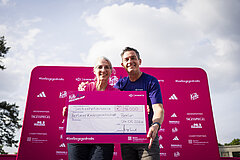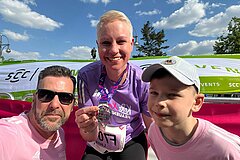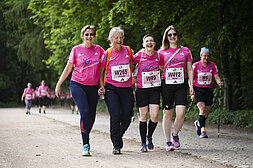Long banned: Long-distance running for women!
When the then 20-year-old American Kathrine Switzer smuggled herself undetected to the start of the traditional Boston Marathon on the morning of April 19, 1967, she had no idea what the consequences of her illegal participation would be. Long-distance races had previously been the exclusive preserve of men. Kathrine Switzer broke a taboo—and what happened at Mile 4 set off a discussion that can be described as a major step in the development of the women's running movement.
The incensed race director Jock Semple tried to push her off the road. Kathrin, however, had taken precautions and enlisted her boyfriend, a 115 kg football player, as a bodyguard. So the organisation boss landed in the ditch, and Kathrine ran on to the finish. These pictures spread around the world.

(Kathrine Switzer at Boston Marathon 1967)
The women's running movement takes off
Four years later, the New York City Marathon, as well as Boston, introduced an official women's classification. In 1973, the first women-only marathon took place in Waldniel, Germany. The pseudo-scientific arguments of the mostly male opponents of women's running, that running harms the female body and is against nature, were gradually reduced to absurdity. Large women's races are becoming more and more commonplace all over the world. The proportion of women in mixed races is also growing steadily; in Germany's parks, you will find Venus more often out running than Mars.
The wave spills over into Berlin
On May 31, 1984, at the premiere of the AVON RUNNING Berlin Women's Run, a total of 645 women took to the starting line of the 10-km race. SCC Berlin, together with Kathrine Switzer, who by then was the winner of the New York City Marathon, and the cosmetics company AVON, set up the first women's run in Berlin. "We were not at all put off by the reactions of some men who asked how we could come to organise a race just for women," remembers Horst Milde, the long-time Race Director of SCC EVENTS. The beginning was made.
"In the following years, the race was always held on "Father's Day" in Berlin's Tiergarten. From the very beginning, the motto was "Running to do good". In cooperation with the Berlin Cancer Society (Berliner Krebsgesellschaft e.V.), donations were collected for women affected by cancer. Here, too, the women's event became an early pioneer for other charity events in Germany.
The breakthrough
In the early years, however, the women's race did not develop very quickly and stagnated with registration numbers around 1,000. Three innovations led to the breakthrough in 1995. The Grete-Waitz-Lopet in Oslo, the largest women's race in the world at the time with over 40,000 participants, was taken as a model, and in lieu of the 10-km distance, it was changed to only a relaxed 5-km fun run. The race was no longer held on Ascension Day, but on the last Saturday in May. The start and finish area moved to John Foster Dulles Avenue and the large meadow next to the House of the Cultures of the World, lovingly known as the "Pregnant Oyster". The 10-km course was vehemently requested by the runners. Their wish was granted.
From the next year onwards, things grew rapidly upwards for both distances. In 1998, after a 10-year break, AVON returned as title sponsor with a total commitment. For the first time, the number of registrations climbed above 2,000. One year later, twice as many women and girls took to the starting line. The women's race grew inexorably, became more and more international and attracted top female athletes from Germany and Africa.

Growth through change
Due to a lack of space, the organisers moved the start and finish line back to the grand boulevard Straße des 17. Juni between the Brandenburg Gate and the Victory Column in 2003. There is plenty of space here to celebrate many more women's sports festivals. The redesign of the Tiergarten with the widening of some of the park paths enabled ever larger registration numbers in the following years. At the same time, the timing of the women's running day was adjusted.
The first start of the 10 km walkers was moved to the early afternoon. The 10-km run, the final highlight of the event, was started in the early evening as the last of eight races. With a record number of 18,598 participants in 2015, the Berlin Women’s Race was able to establish its position as by far the largest women's run in Germany.

(Katherine Switzer 2012 at the start in Berlin)
Germany's largest charity women's run
The COVID pandemic made it impossible to hold the running event in 2020 and 21. After this dry spell, the women-only event was relaunched in May 2022 with fresh momentum and a new title sponsor. The KoRo Women's Race Berlin is considered the largest charity women's run in Germany. The commitment to the fight against cancer is the focus—as is the shared joy of running.




















![[Translate to Englisch:] [Translate to Englisch:]](/fileadmin/_processed_/4/0/csm_Freude-Frau-Ziel_7e116013de.jpg)



![[Translate to Englisch:]](/fileadmin/_processed_/0/7/csm_frau-nordicwalking-ziel-Frauenlauf-2023_edbdbbf8e0.jpg)

![[Translate to Englisch:] [Translate to Englisch:]](/fileadmin/_processed_/c/c/csm_TW1_8476_00fd8e76d0.jpg)
![[Translate to Englisch:] [Translate to Englisch:]](/fileadmin/_processed_/f/0/csm_Team_SCC_Frauenlauf_Solidarisch_in_pink_a0f725c8d9.jpg)